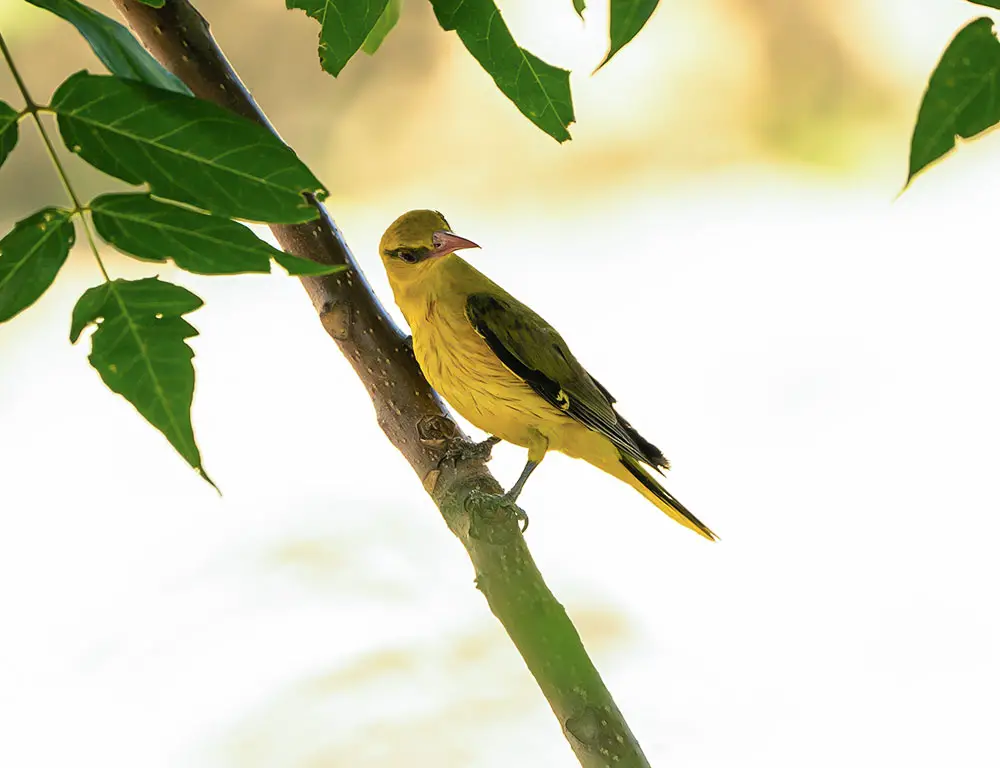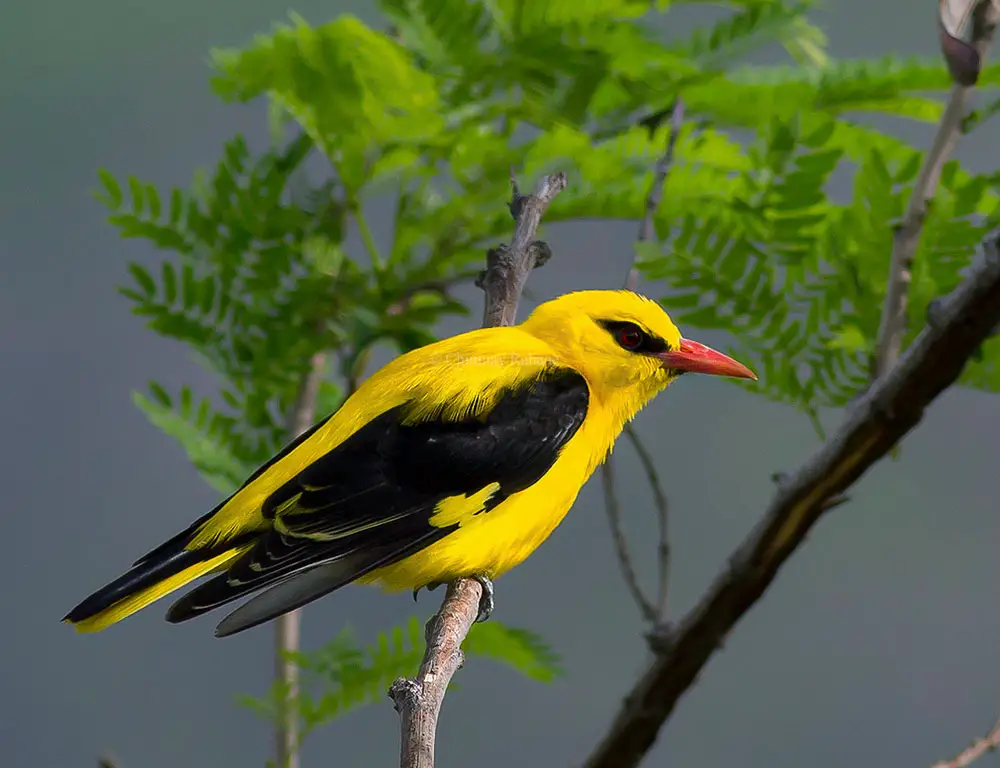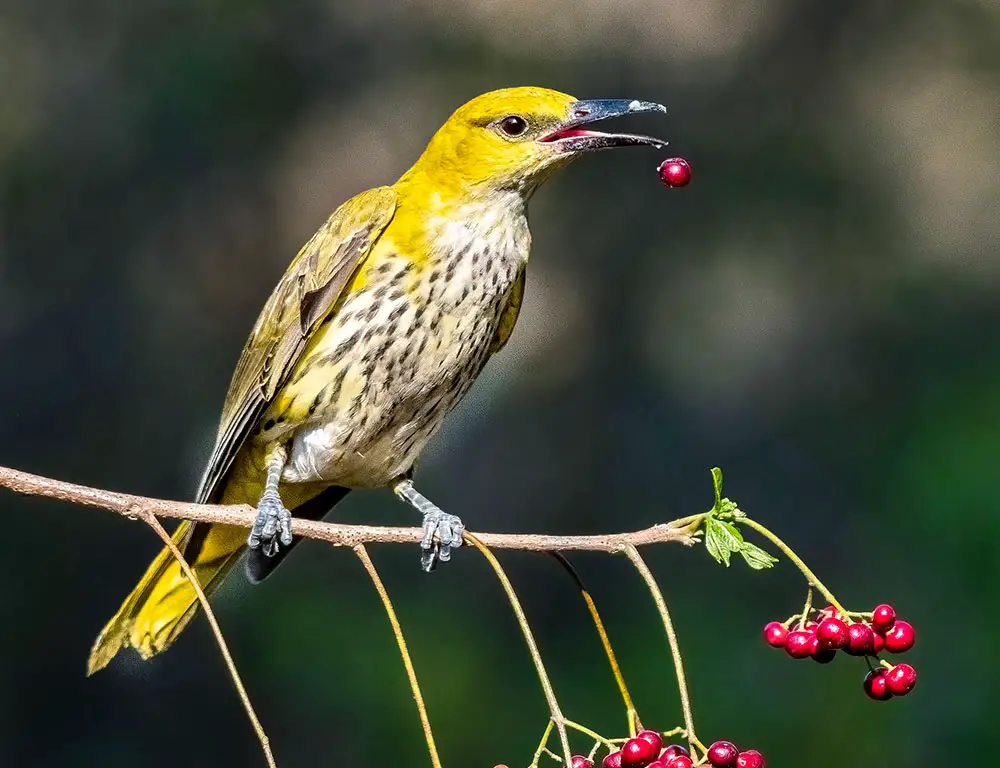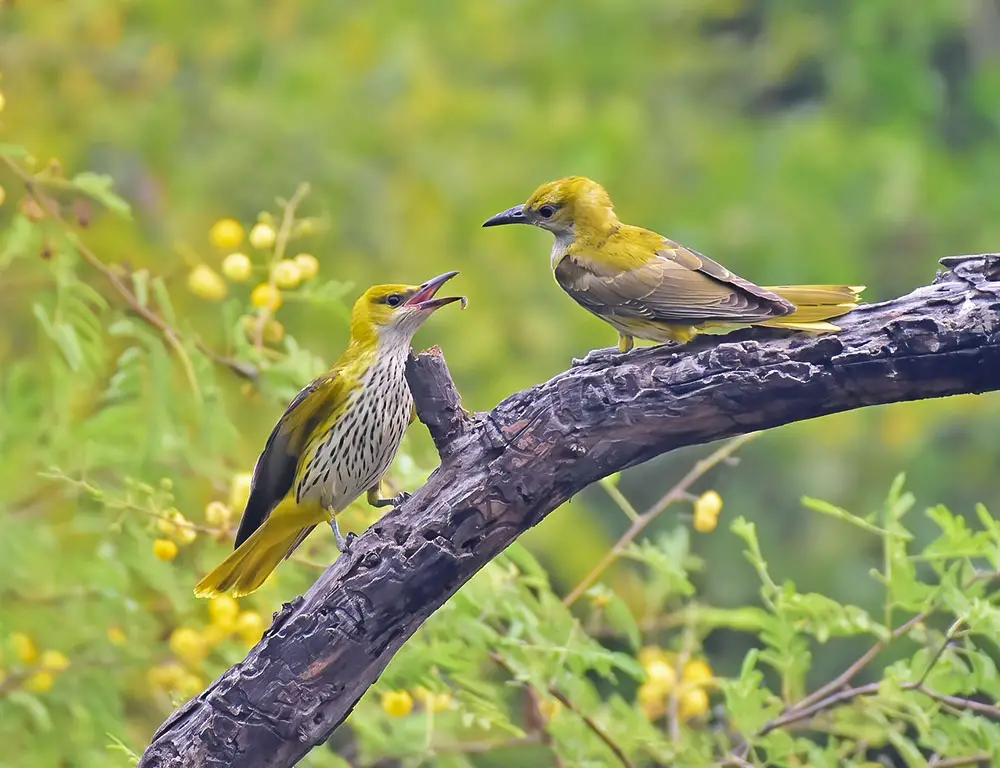Enthralled by the vibrant world of avian diversity, one particular species stands out: the Indian Golden Oriole. Native to the lush landscapes of the Indian subcontinent, this bird captivates with its striking golden-yellow plumage adorned with contrasting black markings.
Found predominantly in wooded habitats like gardens, orchards, and forest edges, these orioles blend seamlessly into their surroundings while showcasing their solid flying abilities.
Beyond their aesthetic appeal, they play a crucial role in ecosystem balance, foraging on insects and fruits and migrating long distances during winter months.
Despite their arboreal lifestyle, their melodious whistle and captivating appearance have earned them admiration as one of India’s cherished avian treasures.
Physical Characteristics of the Indian Golden Oriole

The Indian Golden Oriole possesses several distinctive physical characteristics that contribute to its remarkable appearance and survival adaptations:
Vibrant Plumage
The most noticeable feature of the Indian Golden Oriole is its strikingly vibrant golden-yellow plumage, which earned it its name. This unique coloration sets it apart in India’s diverse bird population.
Sexual Dimorphism
Males of the species exhibit more vivid coloring compared to females. Their black eye stripe extends into a sleek, pointed crest, enhancing their visual appeal.
Size
On average, males measure between 23 to 25 cm in length, while females are slightly smaller, ranging from approximately 21 to 22.5 cm. Both sexes have a wingspan spanning from 44 to 47 cm.
Body Weight
The body weight of Indian Golden Orioles typically ranges between 60 to 80 grams for both males and females, allowing for agile flight and maneuverability.
Plumage Details
Male orioles feature bright yellow bodies with contrasting dark flight feathers and tail streamers, while females exhibit a more muted yellow-green coloration with greyish wings.
Bill Shape and Color
The Oriole’s bill is sharply pointed and slightly curved downwards, facilitating efficient insect feeding. Male orioles have black bills, whereas female orioles boast pinkish-brown bills.
Juvenile Plumage
Young Indian Golden Orioles display distinct markings with dark scalloping on the upper parts and streaking below. This juvenile plumage gradually changes as they molt into their adult feathers.
Habitat and Distribution of Indian Golden Orioles

The Indian Golden Oriole exhibits a wide habitat range and distribution pattern, showcasing its adaptability and presence across various regions:
Habitat Preference
- Diverse Habitats: Indian Golden Orioles are well-adapted to various habitats, ranging from dense forests to urban gardens.
- Preference for Deciduous Forests: They tend to favor open deciduous forests and woodland edges, where they can find suitable nesting sites and abundant food sources, particularly fruiting trees.
- Urban Adaptation: These birds have shown a remarkable ability to adapt to urban environments, increasingly inhabiting orchards and extensive gardens within metropolitan areas.
Distribution Patterns
- Migration: Indian Golden Orioles are migratory birds, spending winters in tropical regions such as Sri Lanka and Southeast Asia. They migrate to these areas to escape colder temperatures during the winter months.
- Seasonal Influence: Seasonal changes significantly influence distribution patterns, with variations observed in population densities across different regions.
Population Density Variation
- Northern India: High population density, indicating a significant presence of Indian Golden Orioles in this region, likely due to favorable habitat conditions and abundant food sources.
- Southern Europe: Moderate population density, suggesting a notable but not overwhelming presence in this area, possibly due to a combination of suitable habitats and seasonal migration patterns.
- Central Asia: Low population density, indicating a relatively sparse presence of Indian Golden Orioles in this region, likely influenced by habitat availability and migratory behaviors.
Diet and Behavior of Indian Golden Orioles

The Indian Golden Oriole’s diet and behavior provide fascinating insights into its life in the wild:
Diet
- Frugivorous Nature: Indian Golden Orioles feed on ripe fruits, with figs and berries as favorites. They also consume mangoes when available.
- Insect Consumption: Insects such as beetles, caterpillars, and spiders form a significant part of their diet. Despite their dainty size, they can tackle larger prey and play a crucial role in controlling insect populations in their habitats.
Behavior
- Territoriality: During the breeding season, male Indian Golden Orioles are highly territorial and aggressive toward intruders. They fiercely guard their intricately woven nests secured onto tree branches.
- Migration: These birds are migratory, migrating to warmer territories like Sri Lanka or East Africa during winter. They return home when spring arrives.
- Vocalization: Indian Golden Orioles are known for their flute-like calls, which echo through woodland habitats in the early morning and late evenings. Some describe their vocal prowess as if they’re serenading the rising and setting sun with their melodious tunes.
Conservation Status of Indian Golden Orioles

The conservation status of the Indian Golden Oriole is currently assessed as “Least Concern” by the International Union for Conservation of Nature (IUCN).
This designation indicates that the species is not facing imminent threats that could lead to a significant population decline. However, ongoing conservation efforts are still necessary to ensure their long-term survival.
Threats
- Habitat Loss: Deforestation, urbanization, and agricultural expansion threaten the Indian Golden Oriole’s habitat. Loss of suitable habitat can lead to a decrease in available nesting sites and food sources.
- Human Disturbance: Human activities such as logging, infrastructure development, and disturbance from tourism can disrupt the natural behavior and habitat of these birds.
- Climate Change: Climate change may alter the availability of suitable habitats and impact food availability for the Indian Golden Oriole.
Conservation Efforts
- Protected Areas: Many national parks and wildlife reserves across India provide protected habitats for the Indian Golden Oriole and other species.
- Awareness and Education: Increasing awareness about the importance of biodiversity conservation among local communities and stakeholders can lead to better conservation practices and habitat protection.
- Research and Monitoring: Continued research and monitoring of Indian Golden Oriole populations are essential for understanding population trends, identifying threats, and implementing effective conservation measures.
Let me share some exciting data with you regarding their global population:
| Region | Estimated Population |
|---|---|
| Europe | 540000 – 1300000 pairs |
| Asia (excluding India) | Not Available |
FAQs
How long do Indian Golden Orioles typically live?
Indian Golden Orioles have an average lifespan of about 7 to 10 years in the wild, though some individuals may live longer in favorable conditions.
What predators do Indian Golden Orioles face in their natural habitat?
Indian Golden Orioles may face predation from birds of prey such as owls and hawks and snakes and mammals like squirrels and monkeys.
Do Indian Golden Orioles migrate in groups or individually?
While Indian Golden Orioles typically migrate individually or in small groups, they may also form larger flocks during migration, especially when traveling long distances.
What is the nesting behavior of Indian Golden Orioles?
Indian Golden Orioles construct cup-shaped nests using twigs, grass, and other plant materials, which they weave together and secure onto tree branches. Nests are often placed in well-hidden locations for protection.
Do Indian Golden Orioles exhibit any interesting courtship behaviors?
During courtship displays, male Indian Golden Orioles may perform elaborate flight displays or sing complex songs to attract females and establish mating bonds.
Conclusion
The Indian Golden Oriole emerges as a captivating symbol of natural beauty and biodiversity. Its vibrant plumage, melodious calls, and fascinating behavior patterns make it a standout bird in India’s diverse avian population.
From its preference for insects and fruits to its remarkable seasonal migrations and sexual dimorphism, every aspect of the Oriole’s existence underscores the importance of conservation and ecological balance.
Through this journey, we’ve uncovered the intricate connection between species and their habitats, emphasizing the need to protect our forests and wildlife.
By sharing knowledge and raising awareness, we can ensure the preservation of these splendid creatures for generations to come. Let’s celebrate the Indian Golden Oriole’s role in enriching our lives and continue our exploration of India’s rich biodiversity with a commitment to conservation.